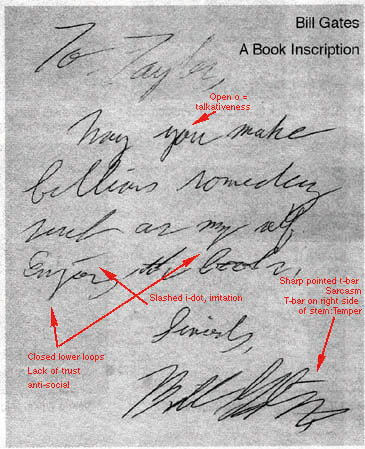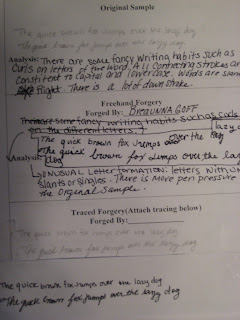History of Handwriting Analysis:
 In the 1622 the first known book on graphology emerged it was written by Camillo Baldi, an Italian doctor of medicine and philosophy, about the analysis of character through the study of handwriting. In the 1870s Jean Michon, a Frenchman coined the name “graphology”, Michon had done much research on the subject and in 1872 his research was published, and it is still used today. In the 1890s Dr. Ludwig Klages, a graphologist, applied the theory of gestalt to graphology, he axpresed his theory of rhythm and "form level" broadening the scope of graphology. To date over 2000 books have been written on the subject of graphology.
In the 1622 the first known book on graphology emerged it was written by Camillo Baldi, an Italian doctor of medicine and philosophy, about the analysis of character through the study of handwriting. In the 1870s Jean Michon, a Frenchman coined the name “graphology”, Michon had done much research on the subject and in 1872 his research was published, and it is still used today. In the 1890s Dr. Ludwig Klages, a graphologist, applied the theory of gestalt to graphology, he axpresed his theory of rhythm and "form level" broadening the scope of graphology. To date over 2000 books have been written on the subject of graphology. List of 12 Handwriting Characteristics
1. Line quality: Do the letters flow or are they written with very intent strokes.2. 2. Spacing of words and letters. What is the average space between words and letter
4. 3. Ratio of height, width, and size of letters: Are the letters consistent in height, width, and size?
Observe your ratios and record your findings. Measure short and tall letters.
Observe your ratios and record your findings. Measure short and tall letters.
6. 4. Lifting pen: Does the author lift his or her pen to stop writing a word and start a new word?
Observe the “lifting pen” habits and record your findings.
Observe the “lifting pen” habits and record your findings.
6. Strokes to begin and end: Where does the letter begin and end on a page?
Observe the “strokes” habits and record your findings.
Observe the “strokes” habits and record your findings.
7. Unusual letter formation: Are any letters written with unusual slants or angles? Are some letters printed rather than written in cursive?
Observe your “unusual letter formation” habits and record your findings.
Observe your “unusual letter formation” habits and record your findings.
8. Pen pressure: How much pressure is applied on upward and downward strokes?
Observe any “pen pressure” habits and record your findings.
Observe any “pen pressure” habits and record your findings.
9. Slant: Do letters slant to the left or right? If slant is pronounced, a protractor may be used to determine the degree.
Observe the “slant” habits. Use a protractor to record your findings.
Observe the “slant” habits. Use a protractor to record your findings.
1 (the image above show the handwriting characteristics of Bill Gates)
10. Baseline habits: Does the author write on the line or does the writing go above or below the line?
Observe any “baseline” habits and record your findings.
10. Baseline habits: Does the author write on the line or does the writing go above or below the line?
Observe any “baseline” habits and record your findings.
1 11. Fancy writing habits: Are there any unusual curls or loops or unique styles.
Observe any “fancy writing” habits and record your findings.
Observe any “fancy writing” habits and record your findings.
1 12. Placement of diacritics: How does the author cross the t’s or dot the i’s.
Observe any “diacritics” habits and record your findings for the top and bottom samples.
Observe any “diacritics” habits and record your findings for the top and bottom samples.
Pictures and Analysis of Handwriting Analysis Template:
The handwriting activity was a difficult process, each person handwriting is unique and matches that person personaltiy. Trying to immitate somebodies handwriting is almost like imitating that persons personality. When my partner and I where forging each others handwriting the difference in my original writing and her forged writing was noticable, my writing was more fancy and flowy than hers was. The tracing technique was easier than free hand forgery because my own handwriting techniques were not used because I was tracing rather than trying to write on my own.
Reflection on the Check Forgery Activity:
My group was able to identify which of the checks was a forgery. In order to forge my partners check I had to analyze their handwriting. This means that I had to observe unusual letters formation, slants, and spacing of words. All of these things are factors that are used to analyze handwrtiting, by determining these characteristics in my partners handwriting I was able to successful forge a signature, but it was easily distingiushable from the original.
Famous forgery case and explain how forensic handwriting analysis was used to expose the forgery:
The Howard Hughes Hoaxs: In 1970 Clifford Irving and Richard Suskind came up with a scheme to to forge an autobiography about howard Hughes a reclusive billionare. To them the plan seemed perfect, because Hughes was so reclusive the men believed that he would never denounce the book. Irving went to McGraw-Hill to publish the book claiming that Hughes has asked him to write the book, Irving even produced forged letters to the publishing company claiming the letters had been written by Hughes. McGraw-Hill agreed to publixh the book and gave Irving $765,000 for the rights to publish the book. When the book was made public Howard Hughes contacted reporters saying that all of this was false. Hughes would only speak to reporters on the phone so a "spectographic voiceprint analysis," a test that measures tone, pitch and volume, was conducted to determine if the speaker was in fact Howard Hughes. After running handwrtiing tests a handwriting expert was fooled by the notes that Irving had forged, but qith these notes combined with the voice, Irving was exposed and confessed before the book was published. He spent 17 months in prison, while Suskind spent five.
Sources:
http://myhandwriting.com/images/billgate.jpg
http://handwritinguniversity.com/barackobama/barackobama_handwriting.jpg
http://graphicinsight.co.za/background.htm
http://www.handwriting.com/facts/history.html
Sources:
http://myhandwriting.com/images/billgate.jpg
http://handwritinguniversity.com/barackobama/barackobama_handwriting.jpg
http://graphicinsight.co.za/background.htm
http://www.handwriting.com/facts/history.html



Sara you need to add pictures to enhance the viewers visual experience of what you're talking about.
ReplyDelete